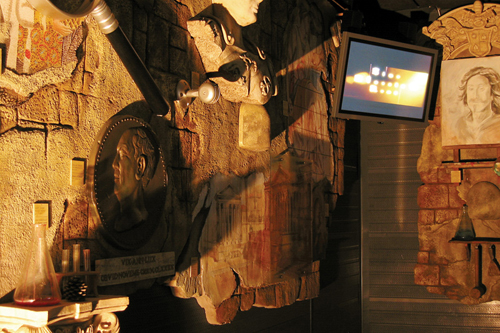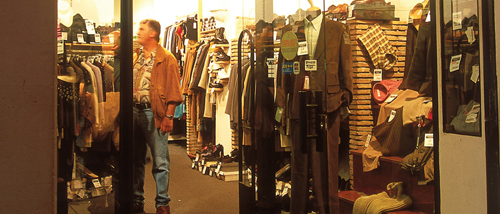The Spanish Steps and Villa Borghese
Here is Rome at its most orderly and elegant, carefully laid out under 16th-century papal urban planning schemes. Baroque popes such as Leo X and Sixtus V redeveloped the all but abandoned area around the Corso, the extension of the ancient Via Flaminia from northern Italy, for their rapidly growing city. Romans now call it the Tridente after the trident of streets – Corso, Ripetta and Babuino – diverging from Piazza del Popolo. It’s an area stamped by a love of theatricality: the beautifully symmetrical Piazza del Popolo; long vistas that stretch down arrow-straight roads; the carefully landscaped Pincio gardens and the lush expanse of Villa Borghese; the stage-set backdrop of the Spanish Steps; the oversized and overwrought Trevi Fountain. It’s also Rome’s most stylishly self-conscious district, famous for its boutiques hawking frighteningly expensive high fashion. Artists have long made their home along Via Margutta, as numerous galleries and antiques shops attest, and Rome’s most elegant passeggiata (the traditional early evening see-and-be-seen stroll) unfolds down the length of Via del Corso.
Rome’s Ex-patsSince Goethe wrote his Italian Journey, Northern Europeans have come here to study and enjoy the sunny clime. Although the Spanish Steps are known as the “English Ghetto” for the Keats residence and Babington’s Tea Rooms, Goethe lived here too. It’s also home to American Express and McDonald’s, and top students from the French Academy are awarded the Prix de Rome to study at the Villa Medici. |

Galleria Borghese
One of Europe’s greatest small museums, worth seeing for its setting alone, is home to Rome’s best collection of early Bernini sculptures (see Galleria Borghese).

Santa Maria del Popolo
A priceless lesson in Renaissance and Baroque art, architecture and sculpture can be found in this spectacular church (see Santa Maria del Popolo).
Pinturicchio fresco, Santa Maria del Popolo
The Spanish Steps and Piazza di Spagna
This elegant, off-centre sweep of a staircase is Rome’s most beloved Rococo monument. It is at its most memorable in May, when it is covered in azaleas, but all year round it is littered with people drinking in la dolce vita (sweet life) and musicians strumming guitars until late into the night. Francesco De Sanctis designed the steps in 1723–6 for King Louis XV, and their true name in Italian is Scalinata della Trinità dei Monti, after the church at the top. The hourglass-shaped Piazza di Spagna, with its Bernini Barcaccia fountain and milling tourists, was named after the Spanish Embassy to the Vatican located nearby.
The Spanish Steps and Piazza di Spagna
Trevi Fountain
Anita Ekberg bathed in it in La Dolce Vita; Three Coins in a Fountain taught us to throw coins backwards over our shoulder to ensure a return visit to Rome (healthier than the original tradition of drinking the water for luck) – thanks to the world of cinema this beautiful fountain is one of the most familiar sights of Rome. The right relief shows a virgin discovering the spring from which Augustus (left relief) built the Acqua Vergine aqueduct, which still feeds the fountain. Nicola Salvi paid homage to these ancient origins by grafting his exuberant Baroque confection onto the Classical architectural framework of a triumphal arch (see Trevi Fountain).
Piazza di Trevi
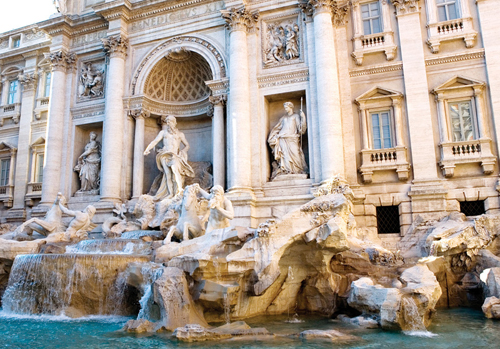
Keats-Shelley Memorial
The pink-stuccoed apartment overlooking the Spanish Steps, where 25-year-old John Keats breathed his last, consumptive breath in 1821, has been turned into a modest little museum dedicated to the Romantic-era British poets who lived part of their lives in Rome (see John keats). Main displays include documents, letters, copies of publications, and Keats’ death mask. Companion Joseph Severn cradled Keats’ head as he died; his resultant drawing of Keats on his Deathbed is also on exhibit.
Piazza di Spagna 26
06 678 4235
Open 10am–1pm, 3–6pm Mon–Fri, 11am–2pm, 3–6pm Sat
Adm
Bust, Keats-Shelley Memorial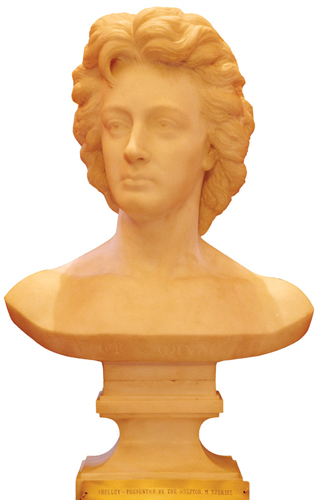
La Barcaccia
Bernini’s father Pietro possibly helped train his son in making this tongue-in-cheek 1629 fountain of a sinking boat. The design ingeniously solved the low water pressure problem by having a boat sprouting leaks rather than jets and sprays.
Piazza di Spagna
Piazza del Popolo
Rome’s elegant public living room started as a trapezoidal piazza in 1538. In 1589, Sixtus V had Domenico Fontana build a fountain crowned with a 3,200-year-old obelisk – the 25-m (82-ft) megalith from Heliopolis, honouring Ramses II, was brought to Rome by Augustus. Napoleon’s man in Rome hired Giuseppe Valadier to overhaul the piazza to its current Neo-Classical look in 1811–24, a giant oval that grades up the steep slope of the Pincio via a winding road. Valadier also added the fountain’s Egyptian-style lions (see Piazza del Popolo).
Piazza del Popolo
Trinità dei Monti
This church, crowning the French-commissioned Spanish Steps, was part of a convent founded by Louis XII in 1503. The twin-towered façade (1584) is by Giacomo della Porta; the double staircase (1587) by Domenico Fontana. The Baroque interior has three chapels. Daniele da Volterra frescoed the third chapel on the right and painted the Assumption altarpiece (which includes a portrait of his teacher Michelangelo as the far right figure), as well as the Deposition in the second chapel on the left. The nearby 16th-century Villa Medici (open for special exhibits) has housed the French Academy since 1803.
Piazza Trinità dei Monti
Open 7am–1pm, 3–7pm Tue–Sun
Free
Trinità dei Monti
Villa Borghese
Rome’s largest green space is made up of 688 ha (1,700 acres) of public park, landscaped gardens, statuary, fountains, groves, pathways, pavilions and a water clock. There are also three world-class museums: Renaissance and Baroque art at Galleria Borghese, ancient Etruscan artifacts at Villa Giulia, and modern art at the Galleria Nazionale d’Arte Moderna. In addition, the Museo Carlo Bilotti, which opened in 2006, houses a permanent collection of contemporary works by the Italian artist Giorgio de Chirico (1888–1978). It’s all thanks to Cardinal Scipione Borghese, who in 1608 turned these vast family lands just outside the Aurelian walls into a private pleasure park, opened to the public in 1901. In 1809–14, Giuseppe Valadier had turned the adjacent space within the city walls into the terraced Pincio gardens, a favourite passeggiata destination studded with statues of great Italians. There’s an elaborate tea house and an obelisk commissioned by Hadrian to honour his lover.
Entrances on Piazza Flaminio, Piazza del Popolo, Via Trinità dei Monti and Corso Italia

Via dei Condotti
The “Fifth Avenue” of Rome, lined with chic shops and fashion boutiques of top-name designers. After flirting with high street retail chains in the 1990s, the street has been re-conquered by the haute couture that made it famous (see Via dei Condotti).
Via dei Condotti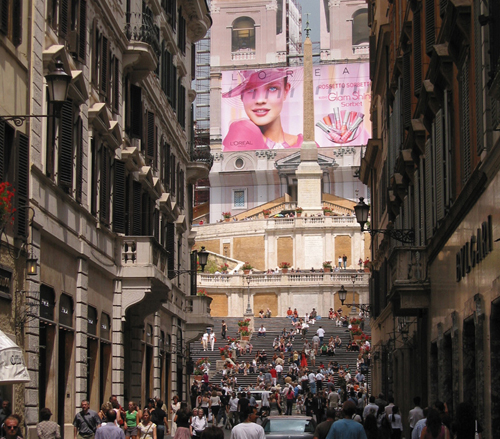
An Afternoon Roman Passeggiata
Begin in Piazza SS Apostoli to see its namesake church (see Santissimi Apostoli) and the 2nd-century AD relief of an Imperial eagle against the portico’s right wall. Then continue straight across Via dell’Umiltà and through the elaborate iron, glass, and frescoed 1880s pedestrian passage. Turn right on Via di Muratte to the Trevi Fountain . Your three coins tossed over your shoulder should ensure a return trip. Leave the square on Via di Lavoratore and turn left on Via di Panetteria for some of Rome’s best gelato at San Crispino .
Turn right up Via del Tritone and left on Via Francesco Crispi for the Galleria Comunale d’Arte Moderna to enjoy a rare glimpse in Rome of contemporary art. Walk down Via Capo le Case and right on Via Due Macelli into Piazza di Spagna and the Spanish Steps . Spend as long as you like window-shopping along the grid of streets west of the piazza, but try to finish up by 5pm so you can work your way north, weaving between Via del Babuino and Via Margutta to see the art and antiques shops, to Piazza del Popolo.
Pause for a cappuccino at Caffè Canova , then cross to Santa Maria del Popolo , with its works by Caravaggio, Raphael and Bernini. Try to get to Santa Maria in Montesanto around 7pm to hear the Gregorian chant, before heading off for a special dinner at Dal Bolognese .
Best of the Rest

Galleria Nazionale d’Arte Moderna
The national modern art museum covers 19th-and 20th-century works. Strongest in Italian art, although foreigners feature too.
Viale delle Belle Arti 131
Open 8:30am–7:30pm Tue–Sun
Adm
DA
Galleria Comunale d’Arte Moderna
The museum covers Italian art from the late 1800s to the mid-1900s.
Via S Francesco Crispi 24
Closed for renovation – call 06 474 2848 for further information
Adm
DA
SS Ambrogio e Carlo al Corso
Roman Baroque church (1669) by Pietro da Cortona, who designed the tribune, cupola and stuccoes.
Via del Corso 437
Open 7am–7pm daily
Free
Santa Maria dei Miracoli and in Montesanto
Carlo Fontana was responsible for these late 17th-century “twin” churches, although Bernini guided him in the decoration of the more elaborate Montesanto.
Piazza del Popolo
Miracoli: open 6am–1pm, 5–7pm Mon–Sat, 8am–1pm, 5–7pm Sun
Montesanto: open 4–8:30pm Mon–Sat, 11am–1pm Sun
Free
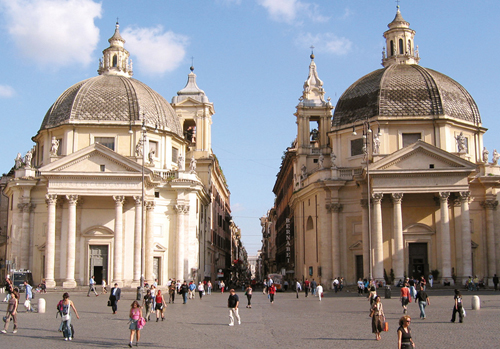
Canova’s Studio
The artist’s studio walls are embedded with fragments of statuary.
Via del Babuino 150a
Open 8am–8pm Mon–Sat
Free
Palazzo Colonna
The gallery features work by Tintoretto, Lotto and Veronese.
Via della Pilotta 17
Open 9am–1pm Sat
Closed Aug
Adm
Casa di Goethe
German author Goethe lived here from 1786 to 1788 (see Wolfang Goethe), and his letters are on display.
Via del Corso 18
Open 10am–6pm Tue–Sun
(guided tours available on request)
Adm
|
Art and Antiques Shops
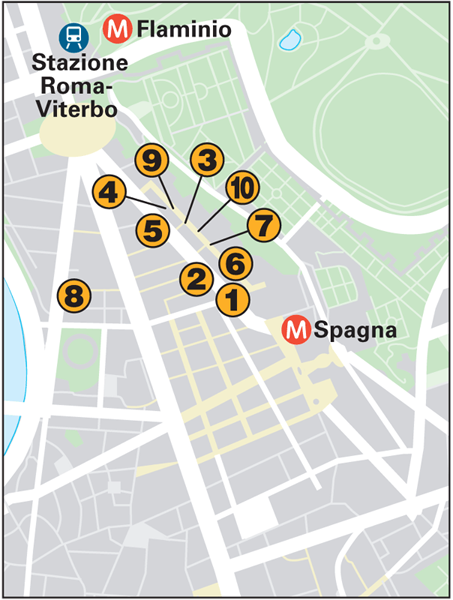
Benucci
Heavy duty art and antiques of the type more usually found in museums – 15th-century Roman and Florentine Virgin and Childs, works by artists such as Luca Giordano or Fra’ Bartolomeo – plus beautiful furnishings inlaid in mother-of-pearl and hardwoods.
Via del Babuino 151–3
Maurizio Grossi
Maurizio Grossi is a specialist in marble. This is just the place to buy a reproduction Roman bust or an astoundingly life-like sculpted fruit.
Via Margutta 109
Alberto di Castro
Etching, lithographs and other prints mostly from the 1660s to the 1920s are on sale in this lovely shop.
Via del Babuino 71
Galleria Augusto Consort
Regularly changing exhibitions of contemporary paintings, watercolours and prints are held here.
Via Margutta 52
Galleria Antiquaria
A small selection of artworks, mostly sculpture, paintings and objets d’art.
Via Margutta 67
Nomades
This eclectic, funky gallery housed in a former convent sells wood, stone and ceramic objets d’art from around the globe.
Via di Ripetta 224
E&R Danon
Mostly 18th- to early 20th-century Oriental carpets and prayer rugs, from Persia and India, Tibet and China.
Via Margutta 36–37
La Bottega del Marmoraro
Homespun Italian homilies carved into scraps of marble are hung pell-mell around a characteristic old workshop.
Via Margutta 53B
High Fashion Boutiques

Prada
The most highly priced of the top Italian designers. A Milan fashion house making minimalist, slightly retro clothing.
Via dei Condotti 92–5
Valentino
Boutique for the prêt-à-porter collection of this native Roman designer in the top echelon of fashion since Jackie Kennedy and Audrey Hepburn donned his clothes in the 1960s.
Via del Babuino 61
Ferragamo
The shoemaker to the stars during Hollywood’s Golden Age of the 1950s hasn’t lost its touch, but it now mass-produces styles rather than creating unique works.
Via dei Condotti 73–4
Gianni Versace
The house of the late fashion designer never compromises the clothing’s flamboyant cuts and garish use of colour.
Via Bocca di Leone 27
Fausto Santini
Gorgeous, classically styled shoes at stratospheric prices.
Via Frattina 120
Fendi
Five sisters founded this Roman fashion empire from their parents’ workshop and reign over Italy’s rage for furs.
Largo Goldoni 420
Philosophy di Alberta Ferretti
Well-cut women’s clothing that is feminine yet powerful and modern.
Via Condotti 34
Laura Biagiotti
Designer who has made stylish fashions for women since 1972. In menswear, she uses the soft wool that has earned her the moniker “Queen of Cashmere”.
Via Borgognona 43–4
Discount and Specialist Shops

Il Discount dell’Alta Moda
This stock house sells mostly men’s and women’s clothing, plus accessories. The staff are genuinely helpful. There are discounts of up to 50 per cent on Versace, Donna Karan, Armani, Dolce & Gabbana and more.
Via di Gesù e Maria 14–16A
Buccone
Historic wine shop with a vast selection and excellent prices. Speciality Italian foods are on sale as well.
Via di Ripetta 19–20
Enigma
Owned by Bulgari, this intriguing shop sells a highly exclusive line of watches and jewellery.
Via Margutta 61
Vertecchi
The queen of Rome’s stationery stores, with hundreds of types of pens (the fancier ones are sold next door at No. 72), thousands of notebooks, and the very best in art supplies.
Via della Croce 70
C.U.C.I.N.A.
The motto of this shop, carrying the best in minimalist kitchenware, is “How a kitchen inspires new appetites”.
Via Mario de’ Fiori 65
Messaggerie Musicali
Huge, ultra-modern music store with dozens of listening stations so you can better select your choice of cassettes and CDs. Tastes range from Italian pop to classic opera.
Via del Corso 472
Tebro
Founded in 1867, this department store specialises in luxury bed linens, towels and lingerie. A made-to-measure service is also available.
Via dei Prefetti 46–54
Remainders
Does exactly what the name says: sells overstock books at up to 50 per cent off their original price, including lots of luxurious art catalogues and coffee table tomes.
Piazza S Silvestro 27–8
Cravatterie Nazionali
Beautiful ties from Valentino, Gigli, Givenchy, Zenga, Gucci and Les Copains at reasonable (for designer) prices and all in one spot.
Via Vittoria 62
Pubs, Cafés and Bars

Enoteca Antica
Delicious antipasti and wine by the glass, are served in this old-fashioned lively establishment.
Via della Croce 76b
Gilda
Rome’s most central disco has remained popular for years, with a pizzeria in the evening and dance music cranking up at midnight. High cover charge on weekends, but always an A-list crowd.
Via Mario de’ Fiori 97
Antico Caffè Greco
Rome’s premier literary café since 1760, best known for its popularity with the 19th-century English Romantic poets (see Antico Caffè Greco).
Via Condotti 86
Thé Verde
Owned by a family of tea traders since 1890, this tranquil, Oriental-style tea-house stocks over two hundred types of tea. Home-made cakes and light meals are also available.
Via Bocca Leone 46
Cinecafé Casina delle Rose
Located in the grounds of Villa Borghese, this café serves drinks and light lunches including salads, sandwiches and some seafood.
Largo Marcello Mastroianni 1
Ciampini al Café du Jardin
Enjoy a drink while watching the sunset at this enchanting café.
Viale Trinità dei Monti
06 678 5678
Closed Nov–Mar
Caffé Rosati
Art Nouveau rival to the right-wing Canova across the piazza, this café has long been the haunt of left-wing intellectuals (see Caffè Rosati).
Piazza del Popolo 4–5
Caffè Rosati
Caffè Canova
The right-wing bastion in the long-standing Piazza del Popolo café war, with cheaper espresso, better ice cream and a restaurant upstairs (the Rosati is more stylish though).
Piazza del Popolo 16–17
Shaki
Post-Modern wine bar serving salads and sandwiches with a few tables outside. They also have a very good speciality foods store at Piazza di Spagna 65.
Via Mario de’ Fiori 29A
Babington’s Tea Rooms
Good for a very pricey spot of tea and other daintily British edibles. Opened in 1893 by a Derbyshire lady, it was the ex-pat hub of the later Grand Tour era.
Piazza di Spagna 23
Places to Eat

Fiaschetteria Beltramme (da Cesaretto)
Regulars and tourists are fitted around communal tables at this ultra-traditional trattoria just down the block from the Spanish Steps.
Via della Croce 39
Closed Sun
No credit cards
Edy
Some of the best food and lowest prices in this high-rent neighbourhood. Mix of seafood and Roman dishes. The candlelit tables out front are a nice touch.
Vicolo del Babuino 4
06 3600 1738
Closed Sun, Mon L
Birreria Peroni
Beer hall with excellent, cheap food sponsored by Italy’s premier brewery – try their “Blue Ribbon” Nastro Azzurro label (see Birreria Peroni).
Via San Marcello 19/Piazza SS Apostoli
06 679 5310
Closed Sun
Dal Bolognese
This restaurant’s popularity rollercoaster is currently on the upswing, with international celebrities again gracing its tables on Piazza del Popolo for classic Roman cuisine in view of the Ferraris parked out front.
Piazza del Popolo 1
06 361 1426
Closed Mon
Abruzzi
The cuisine here hails from the owners’ home in the nearby Abruzzi mountains, as the name suggests.
Via del Vaccaro 1
06 679 3897
Closed Sat
Hosteria St Ana
Warren of basement rooms plastered with photos of famous patrons. Classic Roman cookery.
Via della Penna 68–9
06 361 0291
Closed Sat L, Sun
Al 34
Excellently priced menus featuring inventive Italian cooking.
Via Mario de’ Fiori 34
06 679 5091
Closed Mon
Il Brillo Parlante
Popular basement eatery packed with locals enjoying huge plates of salad and delicious pizzas.
Via della Fontanella 12
06 324 3334
Closed Mon L
L’Archetto
The cast from nearby Teatro Quirino head here for more than 100 pasta sauces.
Via dell’Archetto 26
06 678 9064
|



